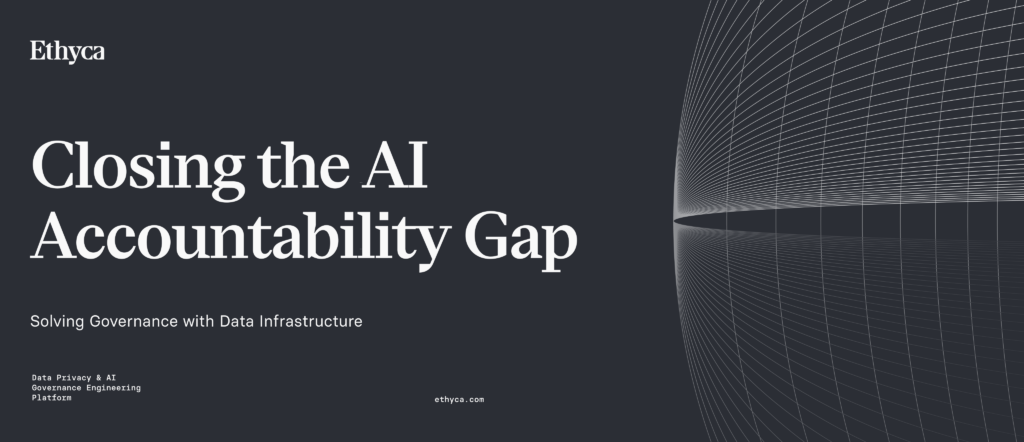Closing the AI Accountability Gap: Solving Governance with Data Infrastructure
Without infrastructure to enforce it, AI governance becomes costly theater destined to fail at scale.

When Workday’s AI hiring algorithm was sued for discrimination in 2024, who was held accountable? The software vendor who built it? The HR team that deployed it? The legal team that approved it? The answer was everyone, and there were few satisfying responses.
It would be something if this accountability vacuum was isolated to hiring algorithms. It’s not. When researchers at Lehigh University found that LLMs flagged Black mortgage applicants as ‘high risk’ 28% more often than identical non-Black applicants, the same question arose: who is responsible when AI systems produce outcomes that are discriminatory, non-compliant and otherwise unreliable in predictable — and unpredictable — ways?
The challenge is an ethical one, of course, but it hits at much more than ethics too. Businesses’ bottom lines are also under threat. A 2022 survey from DataRobot revealed that 62% of companies lost revenue due to AI systems making biased decisions.
The pattern has echoes of several high-profile cases, including when Google/YouTube agreed to pay $170 million for violating the Children’s Online Privacy Protection Act for collecting personal information from viewers of child-directed channels without first notifying parents and getting their consent, despite having policies in place.
That was before the rapid rise of AI technology, which only increases the risk. More and more enterprises are now asking ‘How do we govern AI?’ — but the accountability gap is not a process problem requiring more oversight. Instead, it’s an infrastructure problem requiring better data governance. And it’s an infrastructure problem that can be solved.
When Everyone is Responsible, No One Is
The Workday case crystallizes a key challenge facing enterprise AI governance: distributed accountability without unified control.
In the lawsuit, a plaintiff alleged that Workday’s algorithmic screening software discriminated against job applicants based on race, age and disability. But who bears responsibility when an AI system produces biased outcomes? The software vendor can argue that it’s providing a tool, not a decision. The HR team might claim they followed approved processes. The legal department could point to vendor certifications and compliance reviews.
This diffusion of responsibility is not an accident. It’s structural.
Modern AI initiatives involve multiple stakeholders across privacy, data, engineering, legal and business functions. Data scientists build models, engineers deploy them, compliance teams review them, business units operationalize them. Each stakeholder operates within their domain expertise, but no single entity has comprehensive visibility into how data flows through AI systems or how policies translate into technical controls.
As organizations rush to deploy AI for competitive advantage — the International Data Corporation (IDC) predicts $1 trillion in productivity gains by 2026 for enterprises leveraging Generative AI — the cost of accountability failures also grows exponentially.
More stakeholders in AI governance paradoxically creates less accountability, not more. Traditional data governance solutions have been additional oversight and policy layers. But that’s not the solution. The solution is infrastructure that makes accountability systematic rather than aspirational.
Why Policy-Driven AI Governance is Often an Expensive Illusion
Most enterprises have responded to AI accountability challenges by building what amounts to governance theater: ethics committees, AI review boards, vendor assessments, approval workflows.
This creates the appearance of control while missing the central issue. According to Gartner, organizations are implementing governance platforms with ‘built-in responsible AI methods’ and ‘risk assessments’, yet when it comes to deployed systems, bias, discrimination and misuse of data persist.
The problem is not insufficient oversight. The problem is inconsistent implementation.
When privacy teams speak about ‘personal data’ and ‘processing purposes’, governance teams discuss ‘data assets’ and ‘critical elements’, and AI teams reference ‘training data’ and ‘model inputs’, they’re describing the same information using fundamentally different taxonomies. This linguistic fragmentation creates accountability gaps where policies exist but enforcement becomes difficult, perhaps impossible.
Traditional governance approaches — those used, at greater and greater risk, by many of the world’s largest enterprises — rely on coarse-grained controls like role-based access management.
But modern privacy regulations and ethical AI requirements demand precision. Regulations like CCPA, GDPR and the EU AI Act require organizations to know specifically what data they can use, for what purposes, with what constraints. When enforcement relies on manual processes and periodic audits, accountability becomes a post-deployment discovery rather than a built-in protection.
The Technical Reality: Infrastructure Beats Intentions
AI systems operate across complex, distributed data landscapes that resist traditional governance approaches. In enterprise environments, data flows from web applications and mobile platforms through intricate processing systems before ending up in databases, data warehouses, and third-party services such as Salesforce, Hubspot or a thousand other applications. Each touchpoint requires consistent policy enforcement, not just documentation.
Unlike traditional applications that operate on predefined datasets, AI systems continuously ingest new information, retrain models and adapt behaviors. A customer service AI might access email data, support tickets, product information and user profiles — each subject to different privacy constraints and regulatory requirements. Without infrastructure that can enforce these distinctions automatically, accountability becomes a manual coordination problem that cannot scale at enterprise levels.
This dynamic is overhauled by machine-readable policy enforcement. When data governance rules are embedded in the infrastructure itself, rather than documented in policy documents, teams can move quickly while staying within established boundaries.
Automated detection of sensitive data usage in machine learning pipelines prevents the kind of post-deployment discoveries that trigger regulatory investigations — and the vastly expensive lawsuits that can follow.
The Infrastructure Challenge: Why Data Governance IS AI Governance
This requires understanding a vital insight most enterprises miss: trying to govern the model is akin to diving into the whitewater and swimming after a canoe that’s already racing down the rapids.
That will never work. To govern the model, you need to govern the data that feeds the model. This reframe reveals why traditional approaches to this problem fail, and fail spectacularly in the new reality where GenAI is everywhere.
In enterprise environments, data originates from dozens of sources — web applications, mobile platforms, third-party vendors, internal databases — and flows through complex processing systems, ending up scattered across databases, warehouses, cloud services and filing cabinets.
To innovate and grow, teams developing AI initiatives need to ask a series of essential questions about this: What data do we have? Who owns it? What can we use it for? Where is it geographically located? What are the associated risks and business benefits? Currently, this requires an extended series of steps, requests, forms and other risk evaluations. It resembles a sort of giant Rube Goldberg machine. It could be funny if it wasn’t so serious.
At enterprise scale, this complexity makes manual data governance impossible. Not only that, they become systemic barriers to AI innovation. Teams spend more time navigating governance processes than building AI capabilities, leading to a decision paralysis that can be costly, even fatal, in the ultra-competitive, AI-driven inflection point of today’s market.
Building Systematic Accountability Through Unified Data Control
The solution requires treating AI governance and accountability as a distributed systems problem that demands engineering solutions, not just policy frameworks. The most forward-thinking enterprises have stopped asking “How do we ensure accountability in AI deployment?”. Instead, they’ve started to ask, “How do we build infrastructure that makes accountable AI automatic?”
This infrastructure-first approach centers on four foundational capabilities that work together to create systematic accountability.
- Data discovery and context: First, organizations need comprehensive visibility into their data landscape before any AI system can operate responsibly. This means automatically identifying what data exists across all systems — from structured databases to unstructured file stores to third-party services. Discovery must also capture critical context: where data originated, how it’s been processed, what permissions govern its use, and what constraints apply to specific individuals or data types.
- Granular Permissions Management: Next, they must move beyond role-based access control to purpose-based permissions that reflect legal and ethical requirements. This capability enables organizations to specify that Joe Bloggs’s data can be used for fraud detection but not marketing personalization, while Jane Doe’s information might have entirely different constraints. These permissions must be machine-readable and automatically enforceable, across all data touchpoints.
- Automated Operations: Third, when teams need to retrieve, modify or delete data in response to regulatory requests or policy violations, the process must be systematic rather than manual. This includes automated data subject rights fulfillment, policy enforcement in machine learning pipelines, and consistent and rigorous application of retention and deletion rules across all systems, no matter how disconnected or distributed.
- AI Policy Enforcement and Monitoring: Finally, real-time governance that prevents policy violations rather than detecting them after deployment. This includes automated scanning of AI training datasets for sensitive information, enforcement of data usage constraints during model development, and continuous monitoring of deployed systems for any compliance drift.
The key insight is that these capabilities must be unified under a common taxonomy that all stakeholders can understand and use. Ethyca’s Fides product suite provides exactly this foundation, built upon the Fideslang universal language that allows all business teams to conceptualize data sensitivity the same way.
When privacy teams, governance specialists, AI engineers and business units all speak the same language about data sensitivity and usage constraints, AI accountability becomes distributed, automatic and robust — rather than centralized, manual and fragile.
This systematic infrastructure enables invaluable AI innovation rather than constraining it. Teams can move quickly because they’re operating within clearly defined boundaries that are technically enforced, not just documented in policy manuals and subject to grey area interpretations that impact both revenue and costs.
The Competitive Advantage of Proactive AI Governance
Organizations that build accountable AI infrastructure gain significant competitive advantages that extend far beyond compliance. When governance is embedded in data infrastructure rather than layered on top of it, teams can move faster as the builders and innovators are freed up to get creative with greater confidence.
The financial impact is substantial. Systematic AI governance helps avoid both the regulatory penalties and reputational and revenue damage that follow high-profile data governance lawsuits. More importantly, they can deploy AI capabilities faster and safer, capturing competitive advantages while competitors stay stuck in traditional governance models, paralyzed by risk, complexity and fear.
Perhaps most significantly of all, proactive systematized governance builds stakeholder trust that becomes a powerful strategic asset, enabling more ambitious initiatives and stronger market positioning.
With regulations across multiple jurisdictions rapidly evolving, the window for proactive governance is narrowing. Organizations can build accountable AI infrastructure and gain competitive advantages, or continue relying on governance theater and face the consequences when policies and processes fail, as they inevitably will.
The choice is binary — master systematic AI accountability and deploy AI at scale while strengthening trust on all sides now, or explain to stakeholders later why AI initiatives failed when the stakes were highest. The time is now.
Want to see how leading enterprises are building accountable AI infrastructure? Book a walkthrough and our team will show you how unified data governance enables both innovation and accountability, at enterprise scale.
AI data becomes legal liability: Impact of the EU AI Act
Read MoreThe EU AI Act’s transparency rules hit August 2, 2025, and most organizations aren’t ready for the data disclosures, documentation, and legal risk they bring
Engineering Data Trust at Scale: A Conversation with Adrian Galvan, Senior Software Engineer
Read MoreAdrian Galvan builds scalable, privacy-first integrations at Ethyca.
From Paper to Power: Reflections on the 2025 Consero CPO Summit
Read MoreAt the Consero CPO Summit, it was clear: privacy leaders are shifting from compliance enforcers to strategic enablers of growth and AI readiness.
JustPark Chooses Ethyca to Power Global Privacy and Data Governance
Read MoreJustPark has selected Ethyca to power its privacy and data governance, enabling trusted, consent-driven data control as the company scales globally.
Closing the AI Accountability Gap: Solving Governance with Data Infrastructure
Read MoreWithout infrastructure to enforce it, AI governance becomes costly theater destined to fail at scale.
The Engineer’s Burden: Why Trustworthy AI Starts with the Data Layer
Read MoreTrustworthy AI begins with engineers ensuring clean, governed data at the source.
Ready to get started?
Our team of data privacy devotees would love to show you how Ethyca helps engineers deploy CCPA, GDPR, and LGPD privacy compliance deep into business systems. Let’s chat!
Speak with UsSign up to our Newsletter
Stay informed with the latest in privacy compliance. Get expert insights, updates on evolving regulations, and tips on automating data protection with Ethyca’s trusted solutions.


